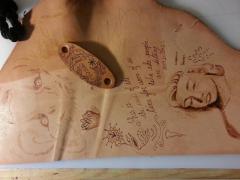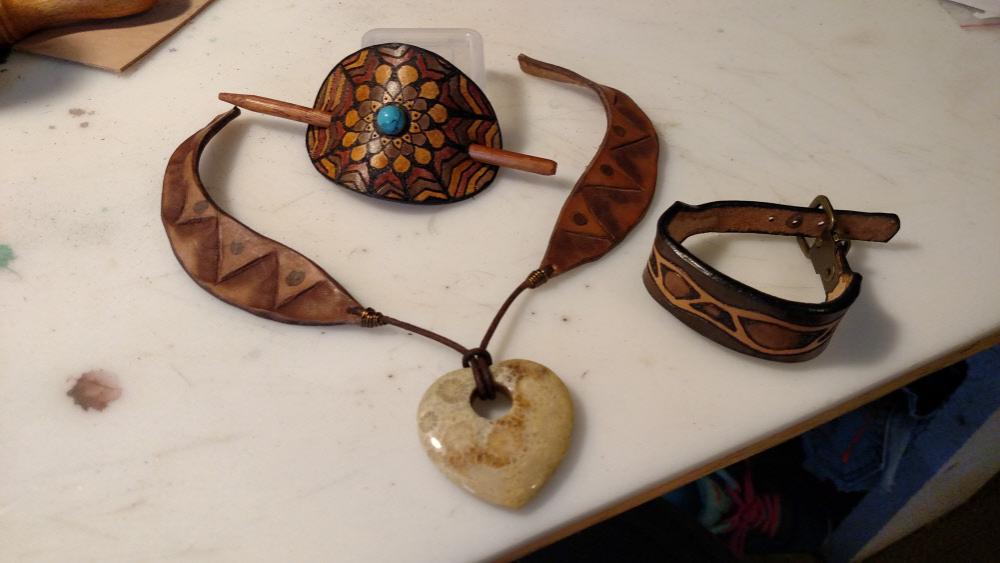Search the Community
Showing results for tags 'flesh side'.
-
Hi all, long time lurker, first time poster. I've read alot about finishing edges on my leather projects, and I've gotten results I'm mostly happy with. However, on some projects, like archery bracers, I have a large area of flesh-side on the bottom which contacts the wearer's skin. Depending on the peice of leather this is sometimes OK, other times a problem. I normally use veg-tan tooling leather, varying quality / types. The flesh side can be anything from almost smooth to furrier than your cat. I've found that if I dye the flesh side, particularly if I use oil based dye (like Fiebing's oil dye) it becomes almost crusty and can feel like sandpaper. I was wondering how others deal with this? Here's some things I've tried in the past: 1. Dye with oil-dye, then coat with leather conditioner (beeswax with other stuff) and burnish, this seems to remove the sandpaper feel but can feel a little waxy afterwards 2. Line the flesh-side with suede - I like this, but it does require more leather and much more time for the glueing and stitching 3. Sand or lightly skive, dye with water-based dye, and burnish with gum trag - never gets totally smooth, will be undone with use The answer may be "buy better leather" but I would be interested to know if there's a good way to come up with a reasonably smooth coloured finish on the flesh side. Any help appreciated.
- 30 replies
-
- flesh side
- burnishing
-
(and 1 more)
Tagged with:
-
I just picked up some boots second hand, which I wouldn't normally do, but they were $10 for a pair that usually costs well over $100. I want to disinfect them prior to wearing them, but since the inside of the bit has exposed flesh side leather, I'm unsure of what to use. I have isopropyl, which I have used before on the grain side with no I'll effects, but I'm not so sure if the same will be true here. Thanks for any advice.
-
Hi all, This question may sound dumb depending on the answer, but I simply don't know and I'm trying to learn. Can I use leather sheen on the flesh side of leather?
- 1 reply
-
- finish
- flesh side
-
(and 1 more)
Tagged with:
-
Looking for a few sweet souls to help me. I'm making bracelets, necklaces, and stick hair barrettes and I really don't want to put backings on them, I'd rather put color on the back but I'm worried about bleeding. I took a scrap strap and put fiebings black pro dye on the back, then tested these things for bleeding... Resolene, gum trag, angelus satan finisher, and edge kote. They felt a little rough to the touch, so I took a wood burnisher and burnished a little. Then I took a damp white rag and rubbed each spot (kinda hard), and some black came through on all 4 things. My questions are many. - I only used 1 coat of those, should I have used 2? - Should I have let the products sit over night before rubbing? - Should I use something else instead of black dye? - Maybe my rubbing is too vigorous, and the bracelets really won't bleed if sweated on or caught in the rain? - Or maybe I DON'T need to color the back? Does it look completely unprofessional? - Maybe I should try to burnish the edges in a way that keeps the black from getting on the back? My current method of burnishing isn't quite right, and I know it. What I'm doing is taking a lip gloss applicator and using it to put black dye around the edges (after I bevel), and then running a bit of beeswax over it while it's still wet, then using a wood burnisher in a dremel. It gets smooth, but I don't know if it will stand the test of time or elements. I know I'm going to have to do it a more correct way eventually. - But could I just find a way to make sure the black doesn't get on the backside, and then use gum trag to smooth it? A consideration: The necklaces are somewhat shaped so they fit snug around the shoulder, but they're shaped to my shoulders which are kind of small. I tried a necklace on my sister, and her shoulders were a little bigger, so it didn't lay flat as it does on mine. So I re-wet it and put it on her for a bit to get her shape, and let it dry and it worked fine. - If I find a way to color the back so it won't bleed, is it going to seal it too much for it to absorb water and be reshaped? Sorry for all the questions. I thought my test on the strap would clear things up for me, but it only put me at more of a loss as to a solution.
-
I've taken on a small project for a friend of mine. It's a wallet-type case for fly fishing flies. He's a big fan of the "all natural leather" look and I would like to leave the inside of the case highly sanded but not slicked so it has that suede-like feel to it. Being that this will be used near the water and is likely to get dripped on etc, I would ideally like to try and protect the inside cover without having to slick it. I'm relatively new to all this and am learning a ton of stuff on this site, but I haven't been able to stumble across anything like this. Would somebody mind educating me slightly? Much appreciated, Matt P.S. I forgot to mention I currently have super-shene, Fiebing's resolene, and Fiebing's leather balm neutral on hand.
-
I will tell you my dilemma first. I have been making beer holsters for my friends for fun. I do not like the look of un-dyed leather on the back part of the holster. (The flesh side that would go against your leg). On the flip side, I am really nervous that if i do dye the flesh side that there is a chance it will bleed onto someone's clothing. I just learned about vinagaroon. Is it possible to just apply it to the flesh side? Or will it bleed all the way through? Does anyone have any experience with this stuff? Thank you in advance for your input!
- 5 replies
-
- vinagaroon
- flesh side
-
(and 1 more)
Tagged with:




